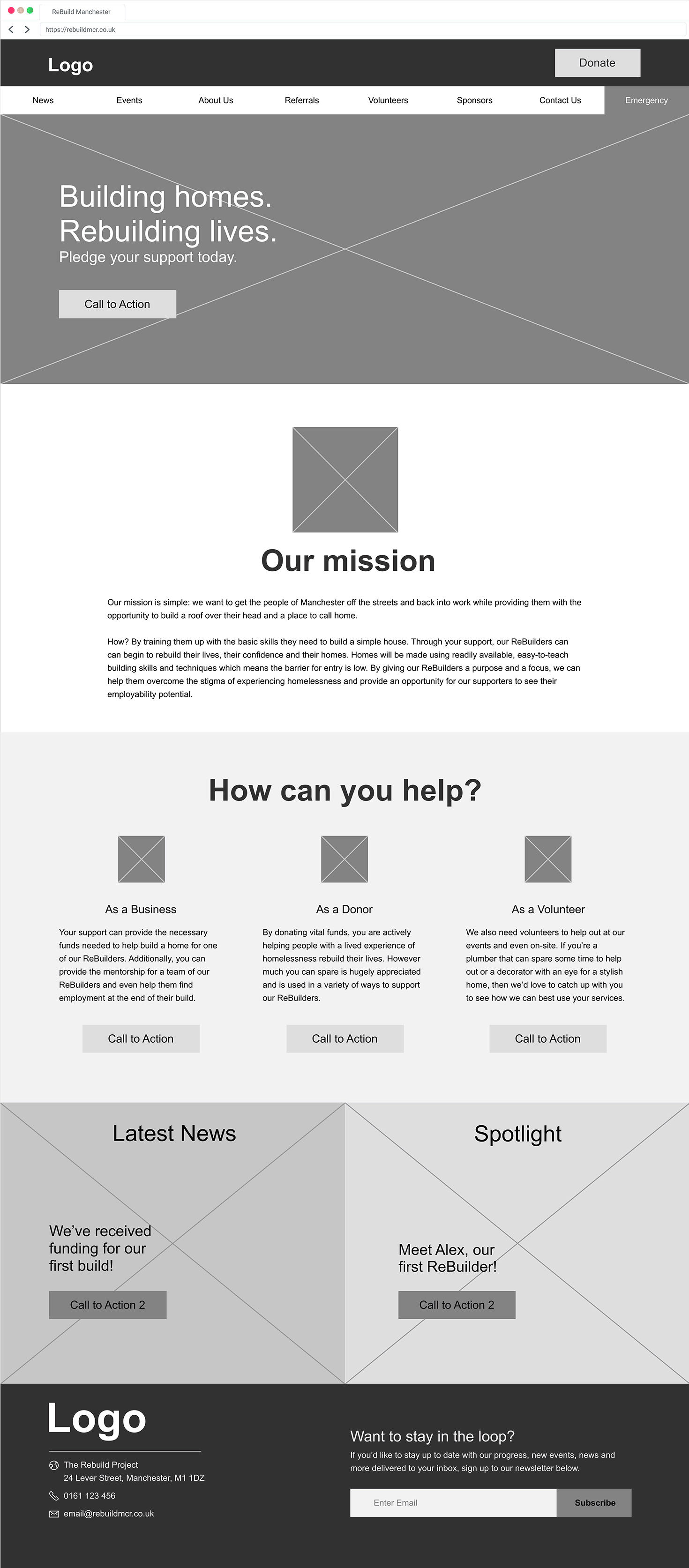
ReBuild Project
Designing a digital platform to help people with a lived experience of homelessness in Manchester get back into employment while simultaneously building a home for themselves.
My Role(s):
User Researcher, UX/UI Designer
Tools & Processes:
Design Thinking, Human-centered Design, Double Diamond, Experience Design, User Research, HMW Statements, Personas, User Journey, Concept, Prototyping, User Testing, Pitching to Clients

Employment is one of the three root causes of homelessness, and one of the key barriers to re-integrating into society for individuals with lived experience of this rising social issue.
Whilst unemployment is at all all-time low – 4.2% as of July 2017 – this covers a multitude of problematic work circumstances which increases the likelihood of people vulnerable to becoming homeless in falling through the net. With over 5.6m people earning less than the living wage – almost 650k in the North West alone – and almost 1m people nationally working on zero hours contracts, making ends meet is challenging.
As part of a multi-disciplinary team, we were tasked with looking at ways of getting people with a lived experience of homelessness back into meaningful work. The team met up with Lauren of Noisy Cricket, Mooch of Big Change and Graham of Street Support, who together form a part of the Manchester Homelessness Partnership.
How can we improve the systemic, cultural and personal process to enable those people looking for gainful employment to find their success story?
For clarity, the team adopted the moniker ‘Alex’ to describe people with a lived experience of homelessness; our team decided that Alex could be used to describe an individual, or multiple people, depending on the context, and Alex will continue to be used similarly throughout the rest of this project.

Through both primary and secondary research, we were able to conclude some initial findings; stigma and perception of homeless people was a major inhibiting factor, as well as a lack of jobs available for Alex and a lack of understanding on how businesses can help. Our research led us to come up with a design problem:
How might we create an environment to get Alex into work and offer them the necessary support to succeed?

Using insights from a brainstorming session, we decided that we should focus on allowing Alex the time and space to reintegrate themselves back into society while providing them with the tools and skills to be able to get them back into meaningful work.
One idea I developed was getting Alex back into work by creating an environment where they can learn skills through working while simultaneously building themselves a simple home. This idea tackles two major problems: the homelessness crisis in Manchester and the housing crisis in the UK.
This idea was titled the 'ReBuild Project'.
Currently in the UK, there is a housing crisis due to an increase in the British population of 1% per year. This means there needs to be around 350,000 homes built in order to reduce the shortage; that would require two cities the size of Bristol to be built every year.
The idea was based on the aim to create jobs for homeless people through employment to build their own houses in a self-built village and takes inspiration from the 'Help Bristol's Homeless' initiative, where shipping containers are converted into simple homes for homeless people.
Companies who want to help but don’t know how can help by making pledges, through financing or providing staff to assist on-site of the build, providing training, mentoring advice and morale-boosting. This will re-engage Alex, help build confidence and skills, and allow for a soft reintegration back into society.

Based on the Walter Segal self-build approach, Alex is taught the basic woodworking skills needed to help build the shell of their home. The Walter Segal approach to construction is uniquely organised so that anyone who can use basic tools such as a saw, hammer, drill/driver, tape measure, etc. can build a house.
No wet trades are used (like bricklaying and plastering) – skills which are difficult to acquire. It is a stripped down system of construction with a highly minimalist and rationalist approach.

There will be a responsive website where Alex and businesses can sign up to work or pledge their assistance through monetary contributions, and volunteers can provide on-site staff to help out with the build. This would be a simple website accessed by Alex and businesses, and also by support officers working with Alex to try and get them back into meaningful employment. As the time spent working might not be paid time, there should be a low impact to Alex’s benefits, meaning they can claim whilst they work.

As Alex and others on the ReBuild Project complete their own homes, they are encouraged to help build new homes which would create a snowball effect and eventually build up a small community of people with a lived experience of homelessness. Additionally, once a home is completed, Alex has a performance review with the business that has pledged their support to the project to determine whether there are further work opportunities available for Alex.

The ReBuild Project can be accessed by businesses who are pledging their support, volunteers, like builders, electricians or plumbers looking to offer their time to train 'ReBuilders' to build their homes and by Alex looking for further information about the project. A responsive website was mocked up to determine how this website might look on desktop or on mobile.



.png)